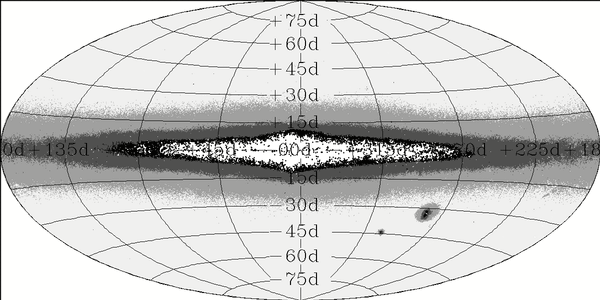Stellar Number Density Metric: "density"
Point source counts are used as a proxy for confusion noise
in 2MASS data processing. The "density" star count metric is
defined to be:
Log [number of stars deg-2] brighter than 14th mag in the Ks band
(2.2 microns).
The density is an excellent measure of confusion noise for most of the sky
(>95%). It breaks down (saturates) for densities greater than 4.5,
corresponding to the Galactic center region. The primary reason the density parameter saturates is that
the detection threshold rises with increasing confusion, so for
the very highest source density regions, the detection
becomes incomplete even brighter than 14th magnitude. Also source blending
renders the integrated flux unreliable.
Read more about the 2MASS Confusion Noise
here.
The density metric is also used to delineate the XSC for analysis purposes
into subsets that have common completeness and reliability properties.
For example, the Level-1
Science requirements apply to the "density" corresponding to minimal
confusion noise from foreground (Milky Way) stars (but see note below).
While the XSC with the highest
density generally is confined to the Plane of the Galaxy -- populated by
extended Milky Way objects (e.g., HII regions) and false positives (e.g., triple stars); see
Visual Inspection of Extended Sources. For the XSC, we typically divide the
samples according to the following density bins:
Density vs. XSC
| density min | density max | %XSC | |Glat| min | |Glat| max |
|---|
| 0.0 | 3.2 | 73.4% | ~25 | 90
|
| 3.2 | 3.6 | 19.0% | ~10 | ~25
|
| 3.6 | 4.0 | 6.9% | ~5 | ~10
|
| 4.0 | 4.5 | 0.7% | 0 | ~5
|
Note: The Level-1 Science Requirements use the Galactic Latitude (Glat) as
a proxy to the confusion noise. This was a convenient assignment at the time of
the 2MASS design & development, but is clearly only a rough guide (see Density vs. MW
image below). The "density" parameter is a much better quantitative measure of
the confusion noise and therefore should be employed when considering the
completeness and reliability of a catalog.
a. Density vs. Milky Way
[Last Updated: 2002 Aug 5; by Tom Jarrett]
